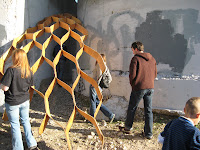
The next step in the process is to merge concepts and ideas with some of the other members of the EFab studio to form groups and begin physically making components for the future installation(s). I have joined forces with a couple students who are into this "venation" or "branching" process. Joining our ideas, I think we can come up with a grid system to begin working with. The specific site chosen for this project is the slope area close to the silos by the 3' retention wall facing the bayou. We chose this space because of the interesting slope situation. I think that alone will affect the grid system we come up with, creating a unique condition for the installation. After the grid has been established, we will begin to make a pattern, a sort of branching along the points on the grid that will be our location where to place the seats. Since we are still interested in creating shading, only some of the seats will have a type of canopy branching out and up from the same seats created. These will have to be light-weight, which is why we are leaning toward using cardboard, as opposed to some other heavy material.



 We had a total of seven individual modules which we put together in the shop at the university and later on site on the day of the big opening. It was a completely different experience assembling the installation at the shop than on site. We needed a lot more help, for one, hanging the installation at its final destination. Putting the holding cable in place around the silo was quite a task, and we would not have been able to do it without all the extra help we got the day of the opening.
We had a total of seven individual modules which we put together in the shop at the university and later on site on the day of the big opening. It was a completely different experience assembling the installation at the shop than on site. We needed a lot more help, for one, hanging the installation at its final destination. Putting the holding cable in place around the silo was quite a task, and we would not have been able to do it without all the extra help we got the day of the opening.































